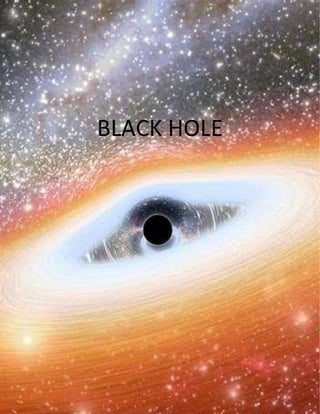
BLACK HOLE.docx
- 1. BLACK HOLE
- 2. A black hole is a region of spacetime where gravity is so strong that nothing, including light, can escape from it. They are formed when massive stars die and their cores collapse under the force of their own gravity. The boundary around a black hole from which no escape is possible is called the event horizon, and the point of no return within the event horizon is called the singularity. Black holes are invisible because no light can escape from them, but their presence can be detected by observing the effects of their gravity on nearby matter, such as stars and gas. Scientists have also detected black holes by observing the X-ray emissions given off by the hot gas falling into them. Black holes come in different sizes, the smallest and most common are stellar black holes which are formed by the collapse of individual stars, and the largest are supermassive black holes which are found at the center of most galaxies, including our own Milky Way. Black holes are still a mysterious and fascinating objects of study for scientists and astrophysicists, and much about them is still not understood. The study of black holes has led to many breakthroughs in our understanding of gravity and the nature of space and time, and continues to be a topic of active research. Black holes are incredibly dense, with a mass that can be millions or even billions of times that of the sun, but they have extremely small sizes. This means that the gravitational pull at the event horizon is incredibly strong, and anything that crosses it is unable to escape. One of the most well-known predictions of Einstein's theory of general relativity is the existence of black holes. The theory describes how gravity works and how it affects the shape of spacetime. The equations of general relativity also predict that black holes should have a temperature and entropy (a measure of disorder or randomness) and that they should emit radiation, a phenomenon known as Hawking radiation.
- 3. Black holes also play an important role in the evolution of galaxies and the structure of the universe. They can merge with other black holes and grow in size, and they can also influence the orbits of nearby stars and gas, affecting the formation of new stars. Supermassive black holes at the center of galaxies can also affect the entire galaxy, by shaping the distribution of stars and gas, and by influencing the rate of star formation. In recent years, scientists have been able to detect the gravitational waves emitted by merging black holes, which has provided new insights into these mysterious objects. The study of black holes is a multidisciplinary field, involving physics, mathematics, and astronomy, and continues to advance our understanding of the universe. In summary, black holes are incredibly dense and massive objects, formed by the collapse of massive stars, that have a gravitational pull so strong that nothing can escape from it. They are invisible, but their presence can be detected by observing the effects of their gravity on nearby matter. They are also important in the evolution of galaxies, and the detection of gravitational waves has provided new insights into these mysterious objects. "Venture into the depths of the unknown - discover the secrets of black holes here!" https://uii.io/black-hole https://uii.io/blac-khole